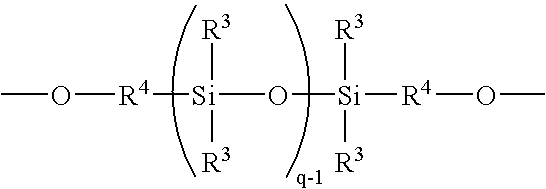Weatherable, thermostable polymers having improved flow composition
a polymer and composition technology, applied in the field of polymer, can solve the problems of long-term color instability of polymeric articles, loss of impact strength, yellowing of polymer or glossiness, etc., and achieve the effects of good flow characteristics, cost-effectiveness, and improved ductility
- Summary
- Abstract
- Description
- Claims
- Application Information
AI Technical Summary
Benefits of technology
Problems solved by technology
Method used
Image
Examples
examples
[0225] The invention is illustrated by the following, non-limiting examples. All parts are by weight unless otherwise designated. GPC data was acquired using an Agilent 1100 Series chromatograph equipped with a UV detector using chloroform as the mobile phase and polystyrene as molecular weight standards. Alternatively, another GPC (Waters Inc. UV detection system) with 100% methylene chloride (toluene flow marker) was used at 1.5 ml per minute on two Polymer Labs Mixed C size exclusion columns connected in series and held at 32° C., calibrated using polycarbonate standards, and analyzed by Waters. Inc. Millennium® software. Glass transition temperature (Tg) was determined using differential scanning calorimetry at a scan rate of 10° C. or 20° C. / minute. All pH measurements were performed using a pH meter and probe, calibrated to standardized buffer solutions.
[0226] The compositions are tested for the following properties: Transmittance (also referred to as “transmission”) (%) was ...
example 6
[0228] Procedure 1 for the preparation of poly(resorcinol arylate polysiloxane polycarbonate). The following were added to a two-liter five-necked glass reactor: resorcinol (35.25 g, 0.32 mol); deionized water (50-70 ml); anhydrous methylene chloride, HPLC grade (450 ml); para-cumyl phenol (1.74 g, 0.008 mol); and methyltributylammonium chloride (0.3 ml of a 75 weight percent solution in water). A solution of a 50:50 mixture by weight of isophthaloyl and terephthaloyl chlorides dissolved in anhydrous methylene chloride (150.1 g of solution, 0.25 mol of diacid chloride) was then added over a period of 10-20 minutes while the pH of the reaction was maintained at 4 to 8 with the addition of 50 wt % sodium hydroxide solution in water. After addition of the diacid chloride, the pH of the reaction was adjusted to 7. The polyarylate mixture was charged with a polysiloxane of Formula XII (5.96 g, 1.8 mmol); deionized water (200 ml), and phosgene (9.7 g, 1.0 g / min., 0.10 mol) while the pH wa...
example 7
[0229] Procedure 2 for the preparation of poly(resorcinol arylate polysiloxane polycarbonate). The following were added to a two-liter five-necked round bottom polycondensation reactor: resorcinol (29.83 g, 0.27 mol); deionized water (50-70 ml); anhydrous methylene chloride, HPLC grade (450 ml); para-cumyl phenol (1.74 g, 0.008 mol); and methyltributylammonium chloride (0.3 ml of a 75 weight percent solution in water). A solution of a 50:50 mixture by weight of isophthaloyl and terephthaloyl chlorides dissolved in anhydrous methylene chloride (150.1 g of solution, 0.25 mol of diacid chloride) was then added over a period of 10-20 minutes while the pH of the reaction was maintained at 4 to 8 with the addition of 50% by wt. sodium hydroxide solution in water. After the complete addition of the diacid chloride, the pH of the reaction was adjusted to 7, and the organic layer containing the polyarylate was extracted from the aqueous layer. The aqueous layer was discarded, and the organic...
PUM
| Property | Measurement | Unit |
|---|---|---|
| percent transmittance | aaaaa | aaaaa |
| transmittance | aaaaa | aaaaa |
| transmittance | aaaaa | aaaaa |
Abstract
Description
Claims
Application Information
 Login to View More
Login to View More - Generate Ideas
- Intellectual Property
- Life Sciences
- Materials
- Tech Scout
- Unparalleled Data Quality
- Higher Quality Content
- 60% Fewer Hallucinations
Browse by: Latest US Patents, China's latest patents, Technical Efficacy Thesaurus, Application Domain, Technology Topic, Popular Technical Reports.
© 2025 PatSnap. All rights reserved.Legal|Privacy policy|Modern Slavery Act Transparency Statement|Sitemap|About US| Contact US: help@patsnap.com



